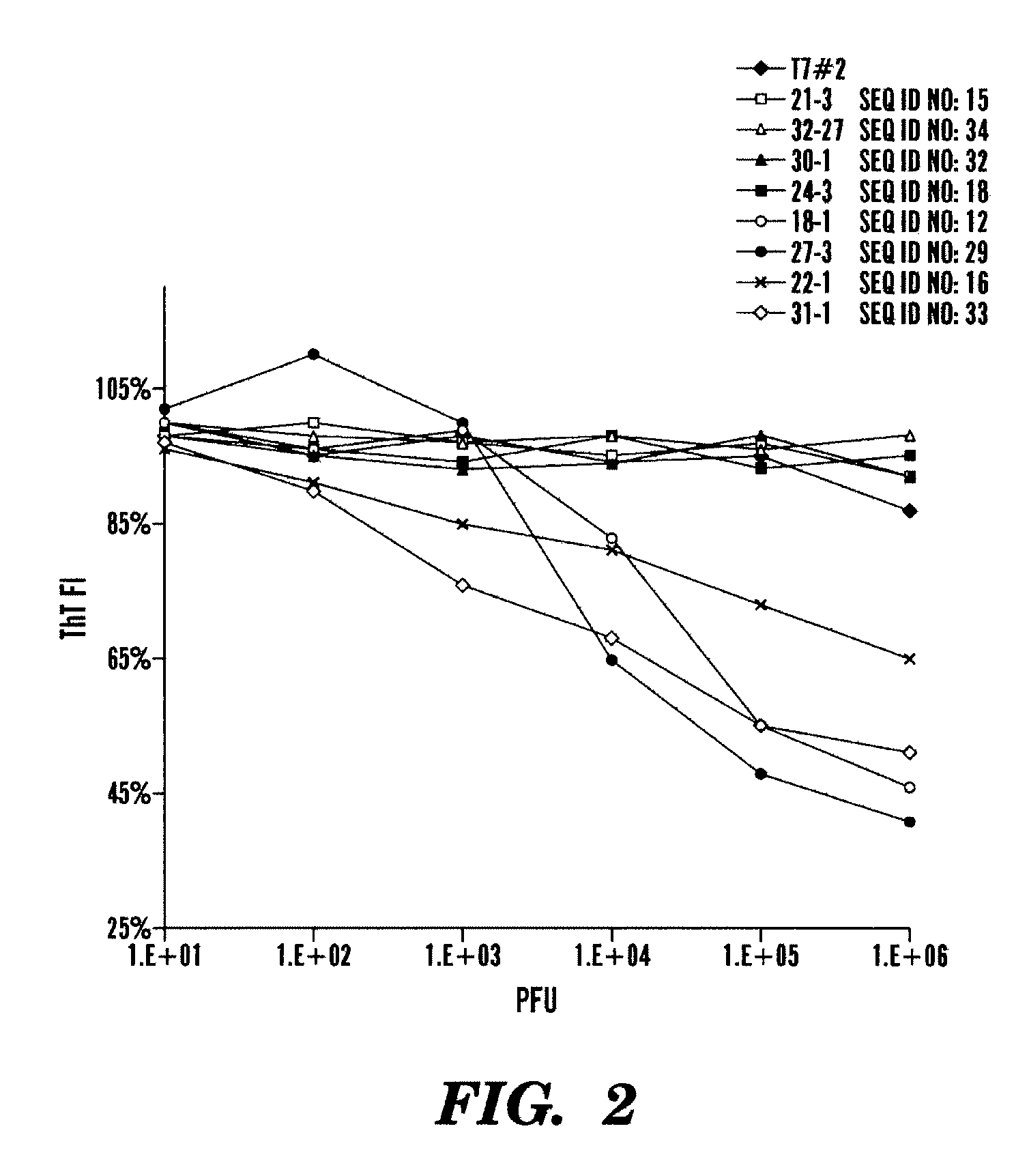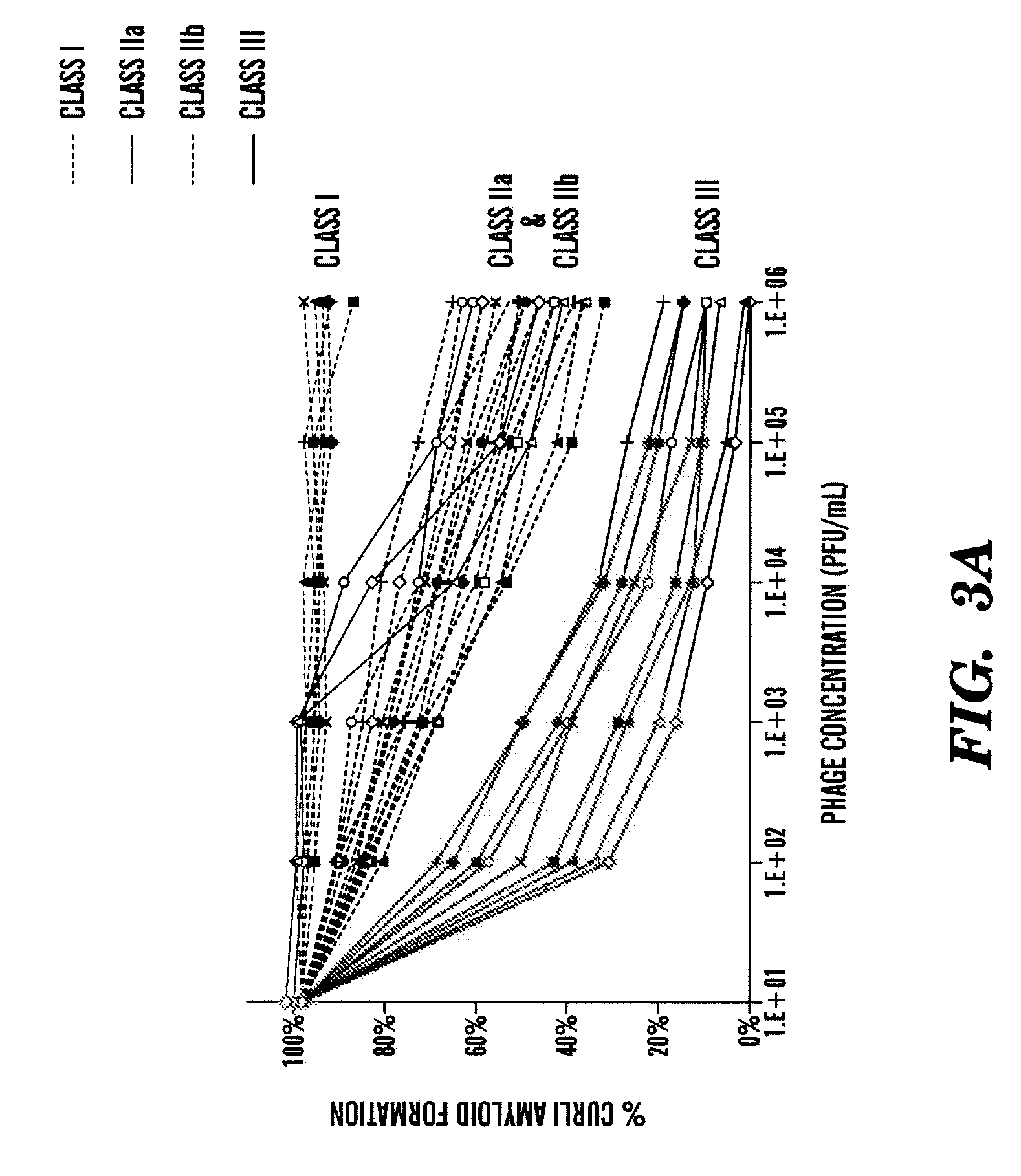Bacteriophages expressing amyloid peptides and uses thereof
a technology of amyloid peptides and bacteria, applied in the direction of peptides, drug compositions, peptides, etc., can solve the problems of difficult disinfection of other industrial surfaces, difficult elimination of bacteria biofilms, and contaminating surfaces of biofilms, so as to prevent the self- inhibit amyloid formation, and prevent the aggregation of amyloid peptides
- Summary
- Abstract
- Description
- Claims
- Application Information
AI Technical Summary
Benefits of technology
Problems solved by technology
Method used
Image
Examples
example 1
[0472]There are amyloids found in humans, yeast, and bacteria. Curli protein in E. coli constitute amyloids (Chapman, M. R. et al. Science 295 (2002)). The inventors first tested whether unmodified phage could block amyloid formation in the absence of capsid-bound peptide-based curli modulators. The inventors monitored in vitro CsgA fiber assembly using ThT fluorescence. As shown in FIG. 1, wild-type T7 phage (T7-wt) exhibited minimal inhibition of curli and Sup35-NM amyloid fiber formation (<15%) while unmodified M13mp18 phage was effective at inhibiting curli amyloids (˜50%) and Sup35-NM amyloids (˜25%). The inventors demonstrated that bacteriophage alone (i.e. non-engineered bacteriophage) was able to block curli formation in vitro. The inventors determined that M13mp18, a filamentous and lysogenic bacteriophage, was more effective than T7, a lytic bacteriophages, at preventing amyolid formation by curli.
example 2
[0473]CsgA is the major curli subunit and is nucleated by CsgB and CsgF (Chapman, M. R. et al. Science 295 (2002); Loferer, H. et al. Mol Microbiol 26 (1997); Hammar, et al. Mol Microbiol 18 (1995)). The inventors designed potential peptide-inhibitors for curli based off of the native amino acid sequences of CsgA (SEQ ID NO: 1) and CsgB (SEQ ID NO:2).
[0474]The inventors designed and expressed specific peptide sequences derived from CsgA polypeptide sequence (SEQ ID NO: 1), as shown in Table 3 and cloned them into the EcoRI and HindIII sites of T7select-415 plasmid from Novagen.
TABLE 3Sequences derived from CsgA that were cloned into T7select-415 plasmid between EcoRI andHindIII restriction sites, the CsgA sequence is highlighted in bold between the EcoRIand HindIII restriction sites (not bold). The nucleic acid sequences(SEQ ID NO: 3-10) encode polypeptides SEQ ID NOs 11-18 respectively.Relevant PeptideNUMBERDNA SequenceSequence17GGGGATCCGAATTCGTCTGAGCTGAACATTTACCAGTACGGTGGCAASELNIY...
example 3
[0479]Next the inventors generated a new set of CsgA and CsgB peptide sequences expressed by bacteriophages for enhanced anti-amyloid activity. The new peptide sequences, shown in Table 5, are variant sequences (i.e. one or more changes amino acid) from the peptides shown in Tables 3 and 4. In particular, the inventors modified (i.e. added, deleted or substituted) one or more amino acid of the CsgA peptides (SEQ ID NOs: 11 or 12), or modified (i.e. added, deleted or substituted) one or more amino acid of the CsgB peptides (SEQ ID NO: 29).
[0480]Further, to see if charged mutations could enhance blocking of CsgA fiber assembly, the inventors mutated key residues within CsgA43-52 (SEQ ID NO: 11), CsgA55-64 (SEQ ID NO: 12), and CsgB133-142 (SEQ ID NO: 29) to lysines (Table 5). The inventors also constructed charged mutations in CsgB142-151 (SEQ ID NO: 30) since the peptide arrays showed that the peptides CsgB130-149 was important for nucleation (Table 5). In addition, the inventors cons...
PUM
| Property | Measurement | Unit |
|---|---|---|
| Fraction | aaaaa | aaaaa |
| Volume | aaaaa | aaaaa |
| Volume | aaaaa | aaaaa |
Abstract
Description
Claims
Application Information
 Login to View More
Login to View More - R&D
- Intellectual Property
- Life Sciences
- Materials
- Tech Scout
- Unparalleled Data Quality
- Higher Quality Content
- 60% Fewer Hallucinations
Browse by: Latest US Patents, China's latest patents, Technical Efficacy Thesaurus, Application Domain, Technology Topic, Popular Technical Reports.
© 2025 PatSnap. All rights reserved.Legal|Privacy policy|Modern Slavery Act Transparency Statement|Sitemap|About US| Contact US: help@patsnap.com



